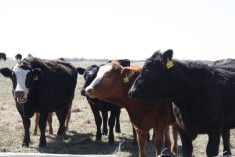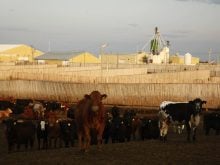This cattle market information is selected from the weekly report from Canfax, a division of the Canadian Cattlemen’s Association. More market information, analysis and statistics are available by becoming a Canfax subscriber by calling 403-275-5110 or at www.canfax.ca.
Fed prices steady
Alberta direct cattle sales saw moderate volume trade last week with prices closing fully steady. Heavy cattle that needed to be marketed were traded, but current feedlot inventories encouraged some feedlot managers to carry cattle over and hold out for stronger bids. Most sales last week were reported dressed at $255 per hundredweight delivered with a full trade range from $254.50-$257 per cwt. delivered.
Read Also

Flax sector sees omega-3 opportunity
SASKATOON — A global shortage of omega-3 oils could be an opportunity for the flax sector, says an industry official….
For the first time in 36 weeks, average steer prices firmed higher than a year ago with steers and heifers averaging around $1.50 per cwt. higher than the same week last year. Western Canadian fed slaughter for the week ending Feb. 13 was 10 percent larger than the previous week at 42,179 head and year to date was up 17 percent at 244,437 head.
Western Canadian steer carcass weights dipped two pounds lower than the previous week and were 19 lb. larger than the same week last year, averaging 911 lb. Canadian fed cattle/cow exports to the United States for the week ending Feb. 6 surged to 11,578 head, up six percent from the same week last year.
The bulk of Ontario trade last week was reported steady with the previous week at $240 per cwt. delivered, with a handful trading at $241 per cwt. delivered. Tru Harvest Meats appears to be on track for March start-up and it continued to procure inventory.
From a supply standpoint, the market tone heading into March appears somewhat bullish despite some of last week’s offering being scheduled out four to five weeks for harvest. Carcass weights should continue to moderate as increased feeding costs encourage timely marketings.
Two packers added Saturday shifts for last week’s kill to make up for the Monday holiday. Spring buying interest is improving, and fed prices are expected to gain seasonal momentum.
In the U.S., light fed trade developed later in the week with live sales generally steady with the previous week at US$113.75-$114 per cwt. in the south and $113-$114 per cwt. in the north.
U.S. steer carcass weights for the week ending Feb. 6 were one pound lighter than the previous week at 919 lb. and were 22 lb. heavier than a year ago. Stocker calves traded unevenly steady last week on limited demand and offerings.
Cow prices push higher
After trading sideways since the start of the year, the cow market has started to make a seasonal push higher. Trading over $5 per cwt. higher, D2 cow prices were at their highest point since October. D2s averaged $81.40 and D3s averaged $69.75 per cwt.
Even though there were some bigger cow volumes in certain spots, in general many commercial auction facilities were reporting 100-150 cows. Last week’s smaller offering could be weather related, but that aside, volumes continue to be much lighter than normal for this time of year.
For the week ending Feb. 13, western Canadian cow slaughter totalled 7,260 head, and for the second week in February this is the smallest slaughter since 2012. In Eastern Canada, the story is much different. Weekly cow slaughter totalled 2,358 head, the largest number for the second week in February since 2012.
So far this year, Eastern Canada is accounting for 22 percent of the total Canadian cow slaughter compared to 17 percent last year. With last week’s price advancement, Alberta cow prices have gone from a discount to now trading near par or a slight premium against the U.S. market.
Feeders set new highs
After a strong start in January, cold temperatures moderated auction volumes in February. Over the previous two weeks, total British Columbia, Alberta, Saskatchewan and Manitoba auction volumes were down 47,800 head compared to last year. Calf and feeder prices continue to set new annual highs, and with the exception of heavy weight heifers, all classes of cattle are trading above last year.
Last week, 500-600 lb. steer calves averaged slightly more than $233 per cwt. In the last three years, this ranks as the fifth highest weekly calf price.
Last week, the Alberta 850 lb. steer cash-to-futures basis was reported at +6.51 per cwt. This is the strongest basis on record for the first half of February. The only year that came close was in 2017 when basis levels were at +0.04 per cwt.
Two weeks ago, on a cash-to-cash basis, Alberta calf and feeder prices were trading at $21-$24 per cwt. premium against the U.S. market. This is one of the strongest cash-to-cash basis levels in history as well.
Given the strength of western Canadian prices relative to the U.S., there might be a large U.S. feeder import volume coming into Canada this month. With strong prices and strong basis levels, it is clearly a sellers’ market.
The forward delivery market was lightly tested, and prices for August-September delivery were steady to roughly $5 per cwt. higher compared to the previous week. Last week, Alberta-Saskatchewan 950 lb. and heavier heifers for August-September-October delivery traded in the mid $170 per cwt. range. Forward delivery prices this month are fully steady with sales seen last year.
Demand for bred stock remains strong, and few if any bred cows are entering the slaughter mix. Bred heifers in Alberta and Saskatchewan averaged $2,015 per head and $1,850 per head, respectively. In Alberta, bred cow and heifer prices are trading around $350 per head higher than last year.
Storm affects U.S. price
In U.S. beef trade, cold winter weather across most of the country caused power outages at some packing plants so they were unable to operate. Maintenance slowdowns had already affected protein production earlier this month.
Cut-out values responded by rallying US$6-$7 per cwt. higher than the previous week, with Choice averaging $238.85 and Select averaging $227.47. Demand for all Choice and Select primals surged as consumers in hard hit areas cleaned out the meat shelves. There was also widespread food spoilage because there was no power to run deep freezes and fridges.
Strong demand is anticipated to restock freezers this week, and prices are expected to firm higher.














